ARTH 4413 Test 1 (copy)
1/37
Earn XP
Description and Tags
Name | Mastery | Learn | Test | Matching | Spaced |
|---|
No study sessions yet.
38 Terms
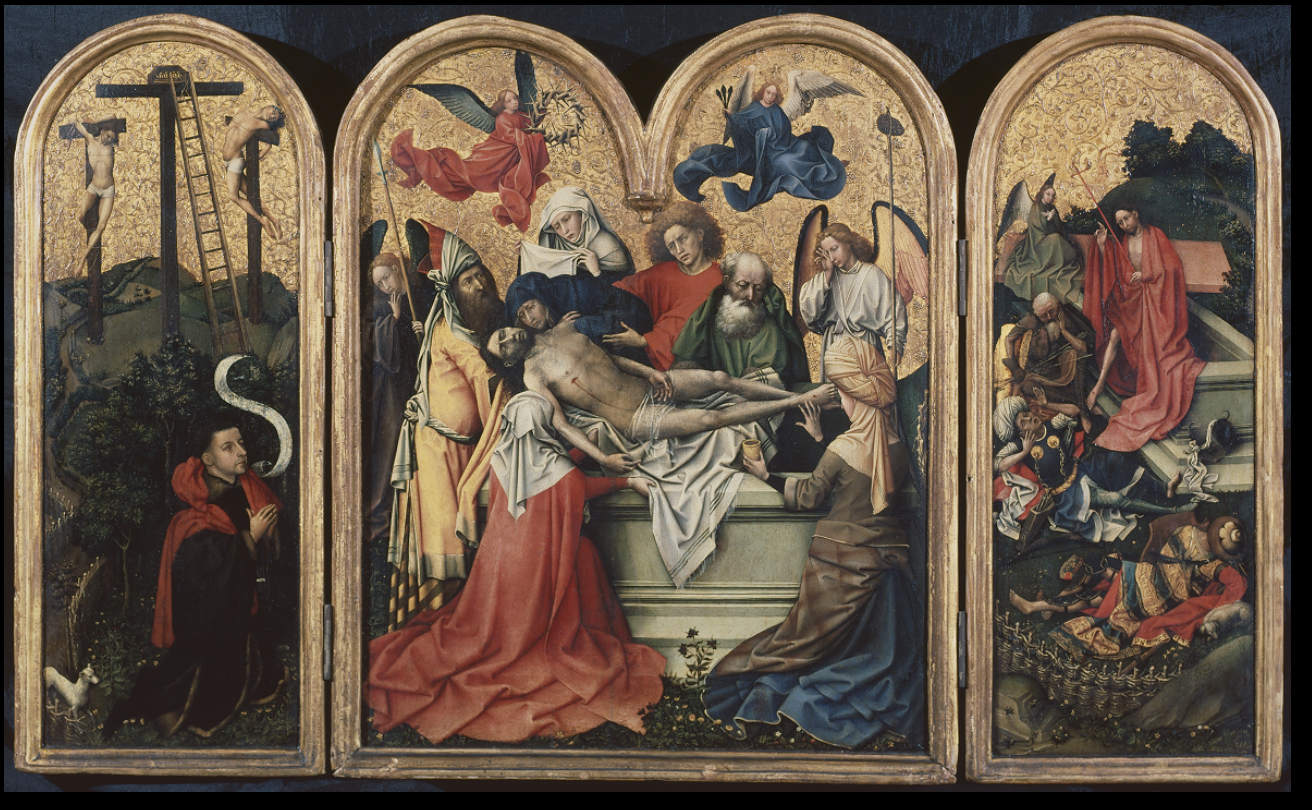
“The Entombment” from (The Seilern Triptych)
Rober Campin
C. 1425
Importance: gold background, one of the first oil paintings, early renaissance, naturalistic and sculptural rather than international gothic style “ars nova”
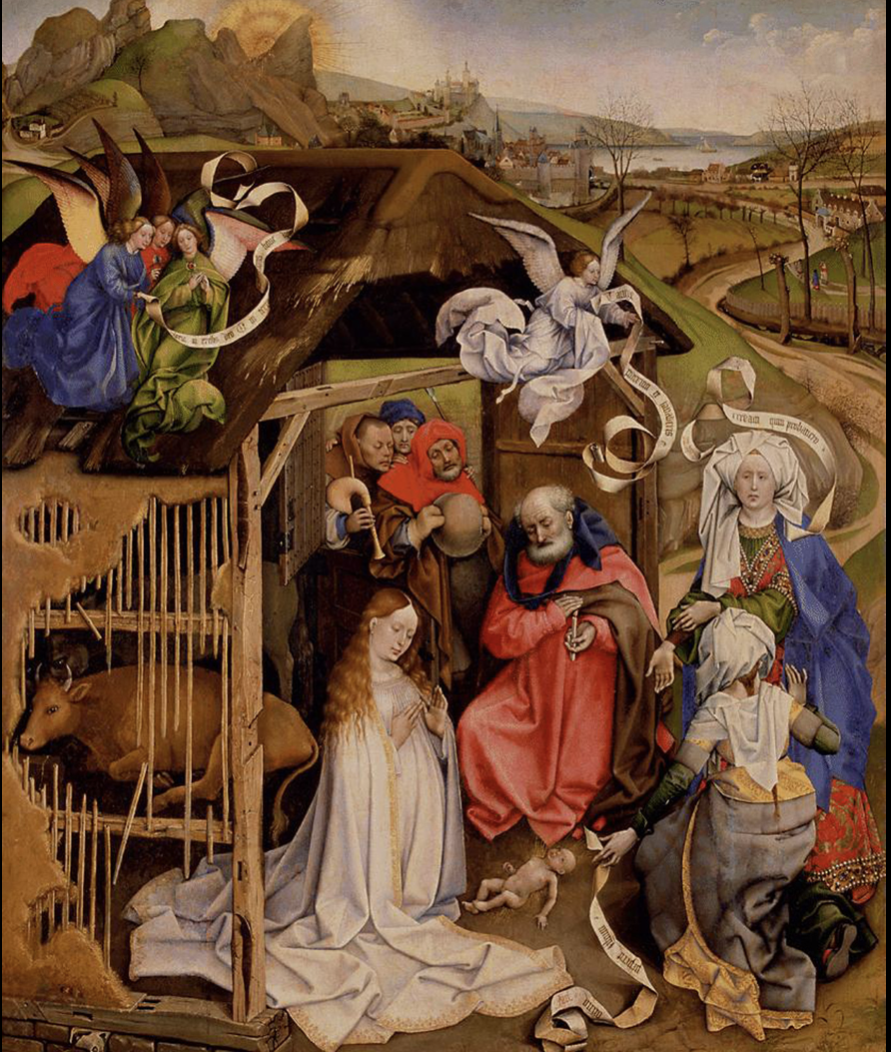
“Nativity” from the Dijon Nativity
Robert Campin
C. 1420-25
Oil on wood
Three different episodes on one panel (nativity, legend of the midwives, adoration of the shepherds)
Apocryphal gospels of the nativity
Expansive background (secular)

“Madonna Breastfeeding, St. Veronica with the Veil, The Trinity”
Robert Campin
C. 1428-30
From a workshop of Campin, parts of a winged altarpiece
Precious gems used in Mary and baby Jesus’s halo (alluding to a projection into space)
Jeweled edges in St. Veronica’s cloak; holds the sudarium (the linen square cloth with an image of the face of Christ); finely painted fabric
Intense colors, variety of textures and contrasts (ie red/white clothing and backgrounds)
Advanced levels of painting to depict a 3D sculpture on a 2D surface
Illusionistic qualities imply the presence of the sacred in our spaces
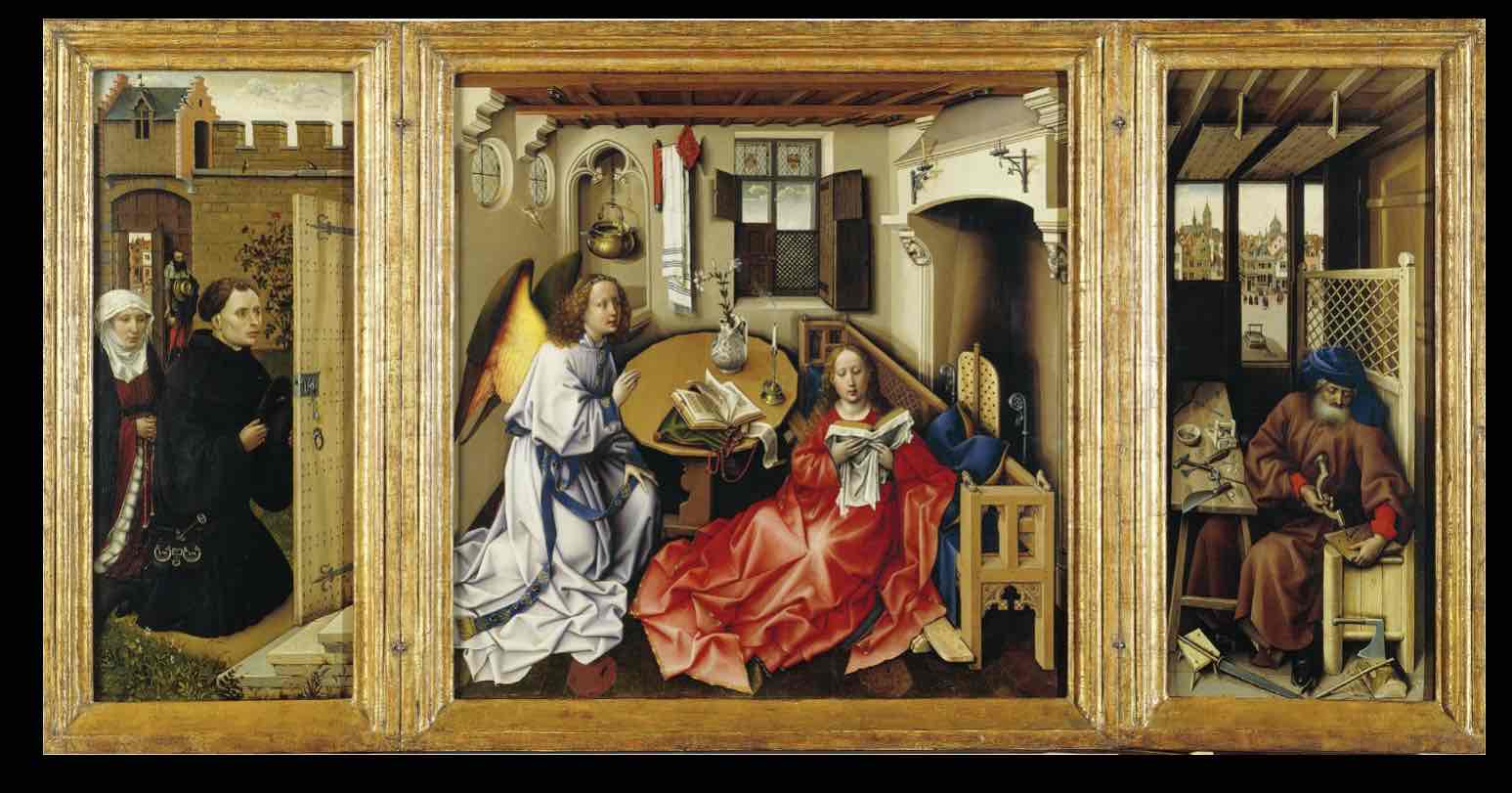
“Merode Altarpiece” (Annunciation, St. Joesph in His Carpentry Shop, and Donors Panel)
Robert Campin
C. 1425-30
Center panel: typical iconography of the annunciation in a 15th century domestic interior
Heaviness, three dimensionality (shadows of light)
Incoherent anatomy
Gabriel is dressed as a Deacon with a white “alb”
Use of primary colors
Strycsitten (medieval bench)
Secular cityscape behind St. Joseph (different perspective)
Donor’s panel = left wing
Depicts Peter Engebrechts (patron) and wife kneeling in prayer by the open door
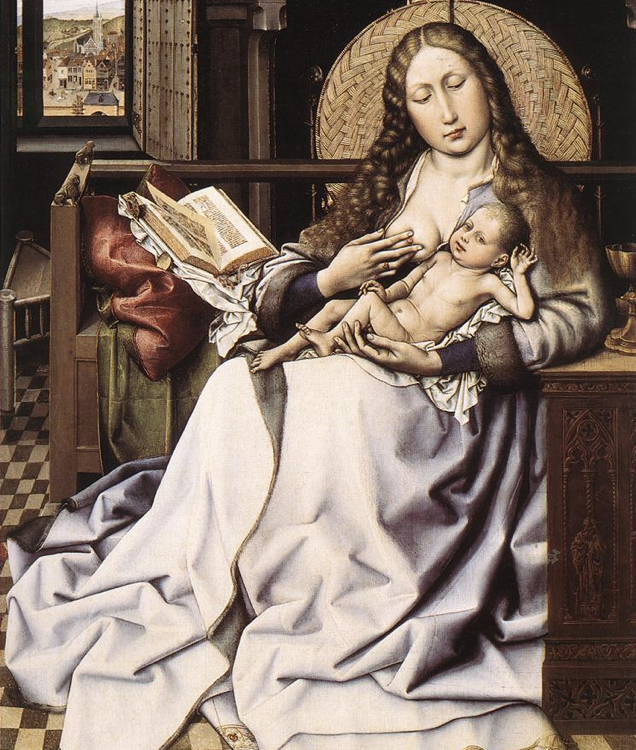
“Virgin and Child before a Firescreen” “Madonna of the Firescreen” “Salting Madonna”
Robert Campin
c. 1430
Heavy form
Strycsitten
Firescreen is an overt symbol for a halo (Similar to a Limbourg piece)
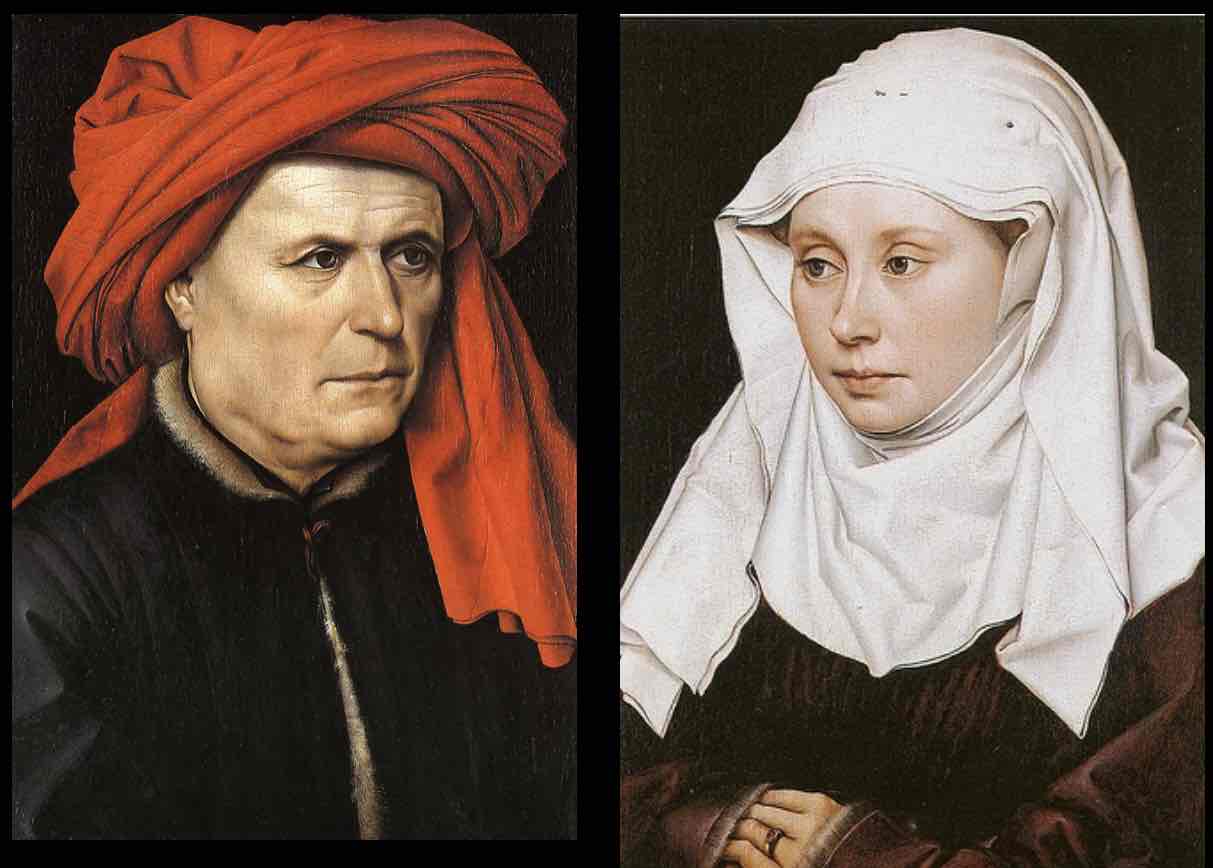
“Portrait of a Man and Portrait of a Woman”
Robert Campin
C. 1435
Pendants
Husband and Wife
Man is wearing a chaperon and fur lined jacket
Realism aspect in the pinned veil, pieces of the veil mimic the corner of the eyes
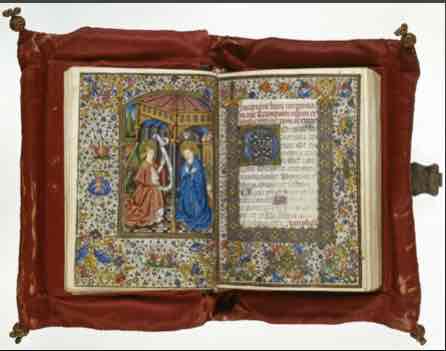
Book of Hours and Medieval Manuscripts
books used for private devotions
Includes Liturgical calendar, perpetual calendar, hours of the virgin, hours of the cross, suffrages of the saints, litany of Saints, office of the Dead, Psalms and Prayers
Literary works of Greek and Roman antiquity; texts of healing
Romance narrative tales
Apocalypses stories that depict the end of the world
Made of parchment
Used ink, gold, and lapis (lapis was more expensive than gold)
Expensive (only for the very wealthy)
Inhabited initial - enlarged letter with human or animal figures with no identifiable narrative scene
Historical initial - enlarged letter with a scene related to the text
Smaller meant to be carried in a pocket, sleeve, or belts
Can be a wedding gifts or family heirloom
Recording marriages, births, deaths, and recipes
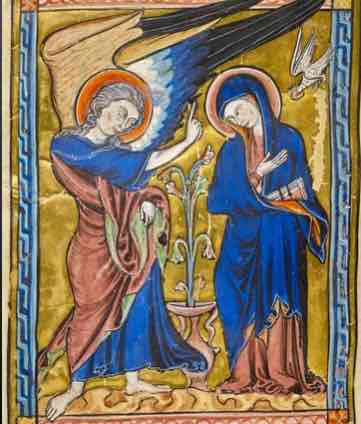
“Annunciation”
Anonymous artist
13th cent.
Uses typical iconography of the annunciation
Iconography of the Annunciation
Mary
on the right
Dressed in blue
Expression of humility and acceptance
Halo
Reading a book
Archangel Gabriel
on the left
Wings and halo
Movement (moment of arrival)
White lilies
Doves (the being of the immaculate conception)
Mary and Gabriel are separated by something (whether it is a pillar, building, or plant)
Iconography of the Crucifixion
central cross
Mary and Saint John the Younger (mourning at the foot of the cross)
Secondary story elements
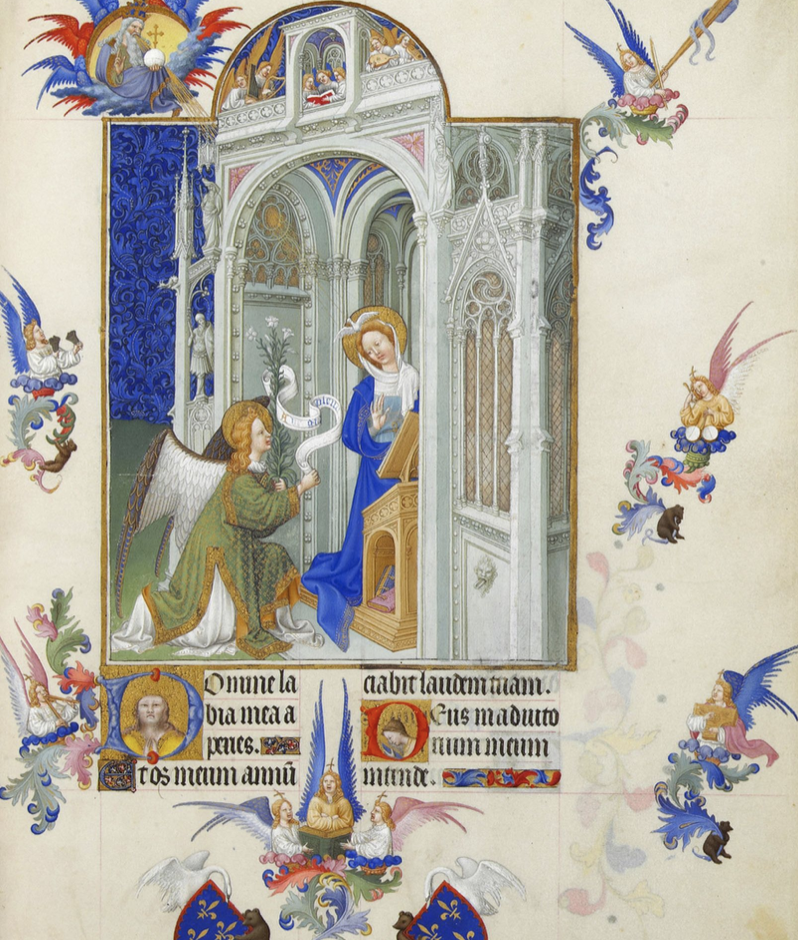
“Annunciation” from the The Belles Heures of Jean de France, duc de Berry
The Belles Heures
206 Folios
131 miniatures
300 gold initials
1800 gilded ornamental borders
Limbourg brothers
C. 1405-08
Opening image of the book of hours
Matins illustration
Gothic chapel
Light through the stained-glass window
Illusionistic sculptures of Old Testament Prophets
Elaborately carved lectern
Three white lilies: trinity
Angels playing stringed instruments
Attributes of the Duc du Berry
Gold fleur-de-lis on blue ground
Bear and swan

“The Hours of Jeanne d’Evreux”
Jean Pucelle
1325-28
209 folios, 25 full pages, 700 images in the margins
Woman’s wedding or coronation book
Italian Trecento style mixed with Parisian Court style
Three-dimensional architecture (not to scale)
Gothic curvilinear forms (S shaped figures)
International gothic style
Grisaille, Drolleries, Bas-de-page
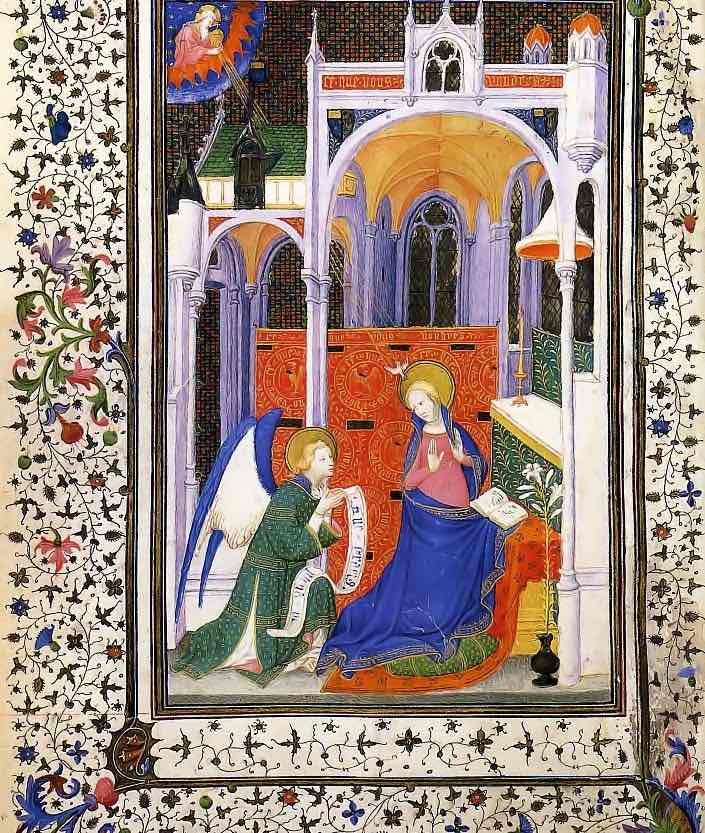
“Annunciation” from the Hours of Marshal Boucicaut
Patron: Jean II, Marshal Boucicaut
wide borders with decoration
International gothic style
Anonymous illustrator
242 folios
New style of landscape depiction
Light and atmospheric perspective
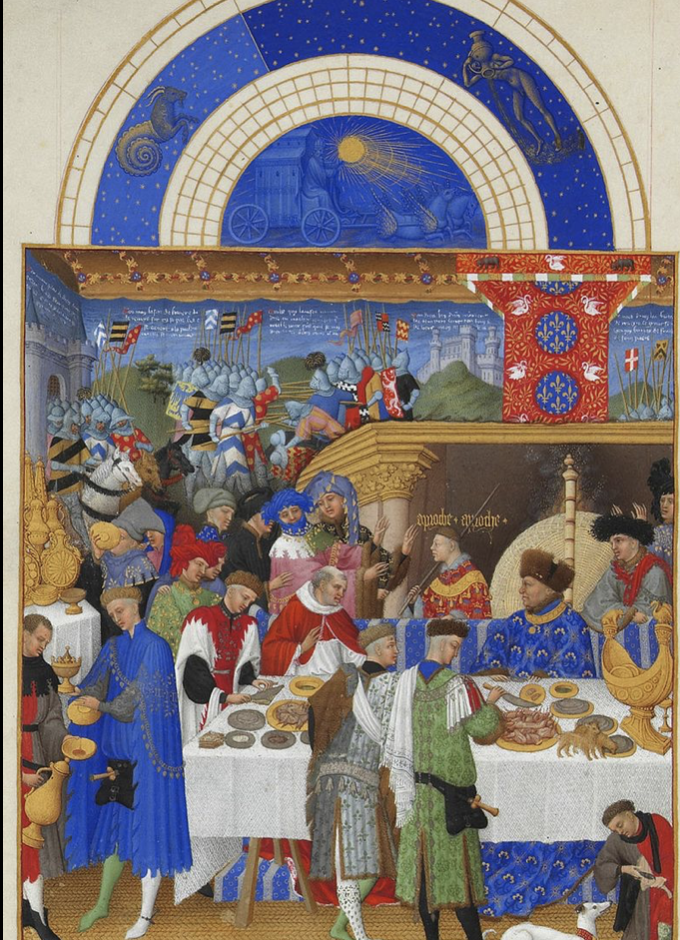
“Folio 1v: January”
From the Tres Riches Heurs
Limbourg Brothers
One of he most famous Book of Hours
Final book commissioned by the Duc de Berry
Importance of calendar (framed with season/zodiac)
Heavy use of lapis lazuli (imported expensive stone)
New Years Celebration
calendar in the top arch
Unfinished
Members of the Duke’s court
Attention to fashion
Possible known serving pieces
Luxury and gift giving
Duc de Berry next to the Firescreen
Uses fashion of the time
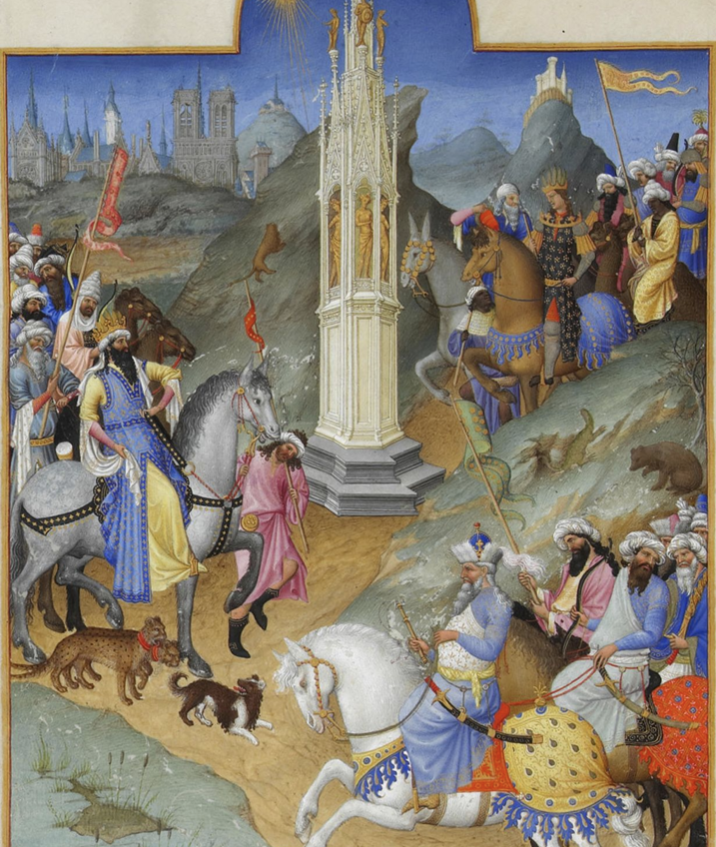
“Meeting of the Maji”
Limbourg Brothers
High horizon
Atmospheric perspective
Wise men arrive in three directions
Patterns on horse’s blankets
Persian textiles
Lavish textural representation
Various animals (Bear is a representation of the Duc de Berry)
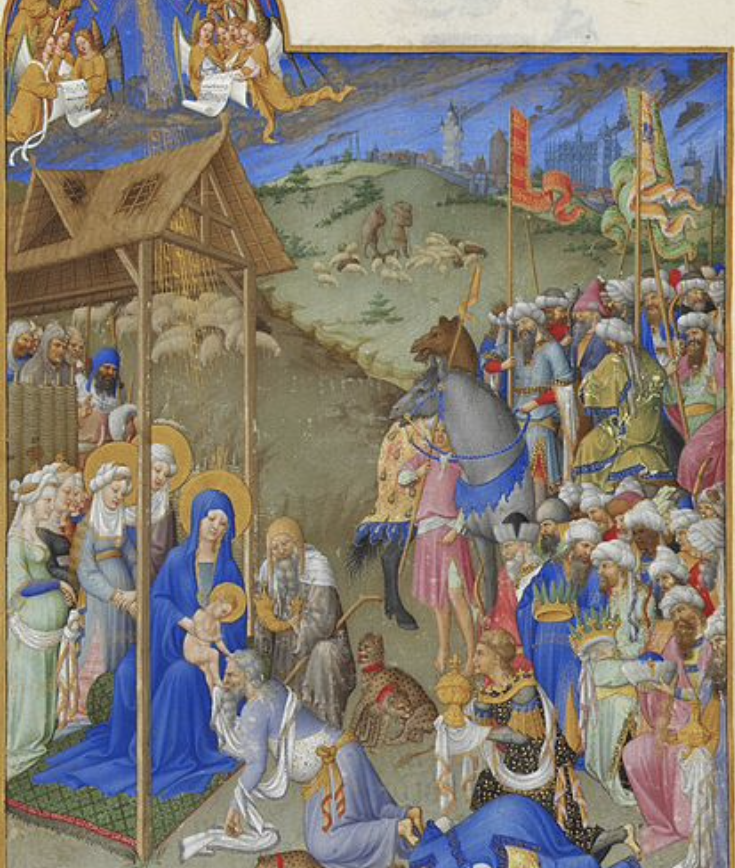
“Adoration of the Magi”
1410-16 and 1485-89
Melchior
Balthasar
Gaspard
Limbourg Brothers
Shepherds in the distance
Women in 15th century dress
Foreign visitors
Joseph as an old man
Cathedral of Bourges in background
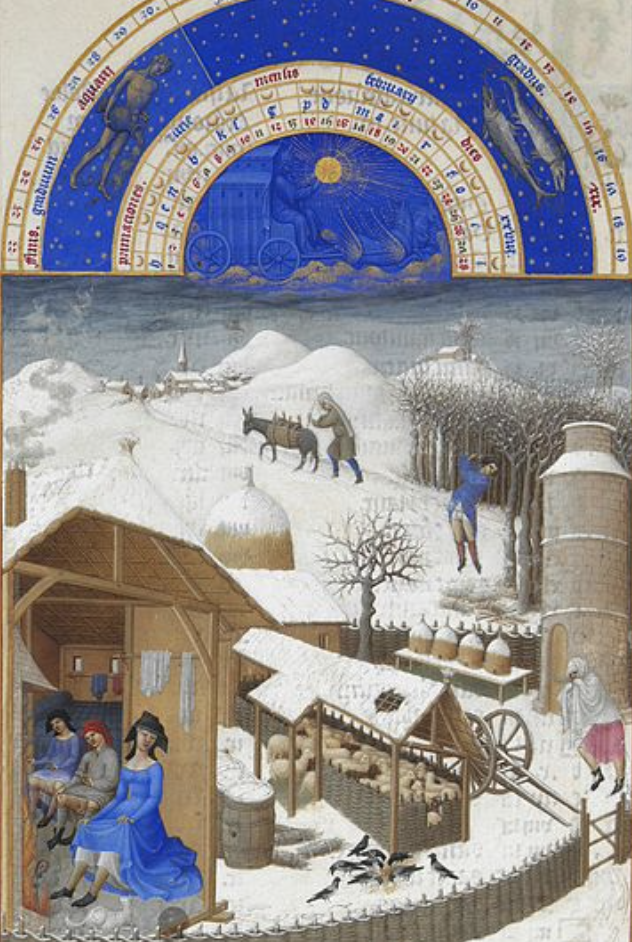
“Folio 2v: February”
From the Tres Riches Heurs
Limbourg Brothers
Aquarius to Pices
Winter (grey sky)
Peasants within a house
Man returning to the warmth of home
can see his breath
Atmospheric innovations
earliest landscape with snow
Smoke from the chimney
Condensation of breath
Footprints in the snow
Snow on haystacks
Sheep huddled together
Birds pecking at seed
Long vista
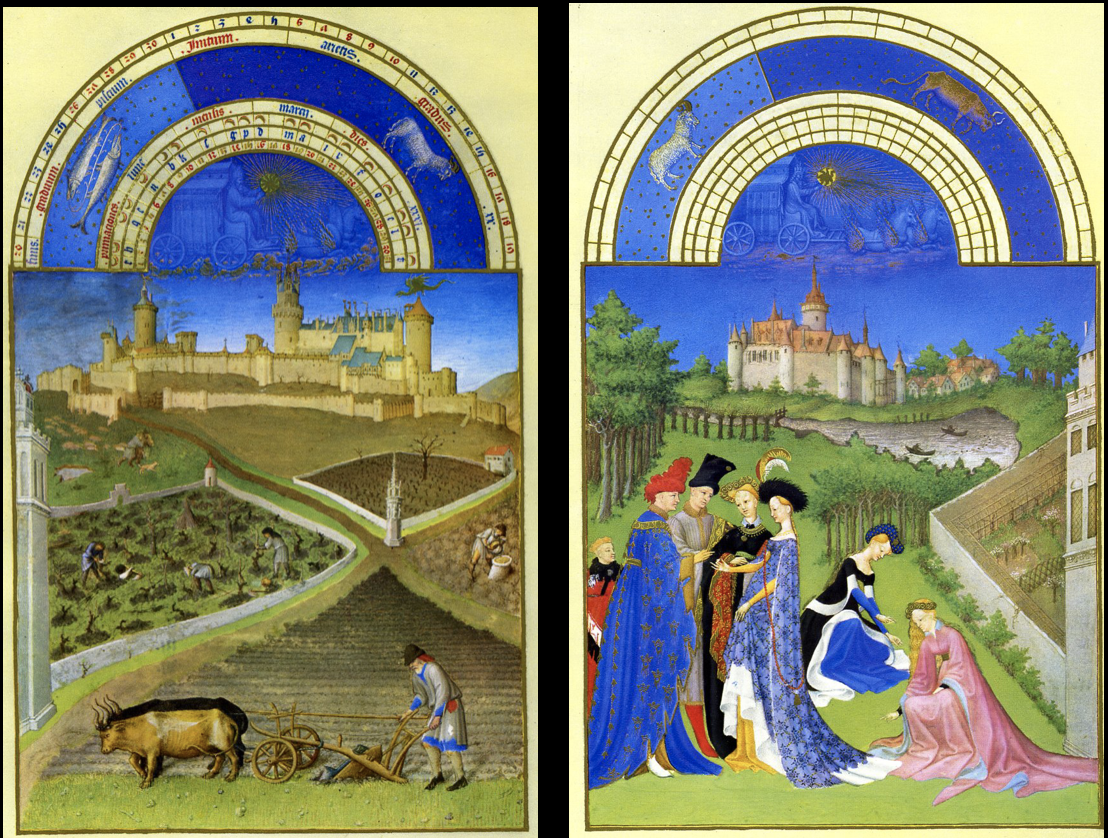
“Calendar: March/April”
From Tres Riches Heurs
Limbourg Brothers
March
landscape like February
Ploughman is representative of rural life
Distinguished between peasants from nobles by dress and occupation
April
golden dragon (a medieval fairytale)
Engagement of Charles, Duke of Orleans and Bonnie d’Armagnac (1410)
Emphasis on luxury and courtly manners (international gothic style)
Large figures in the foreground
Iridescent robes
Emphasis of colo
Prince garments (gold crowns, fur trimmed)
Subtle emotion
Incipient naturalism
natural effects applied to lower class and animals, but not to aristocrats or biblical figures

“Calendar: June”
From Tres Riches Heurs
Limbourg Brothers
Duc de Berry’s Summer home
hotel de Nesle
Conciergerie
two orange conical towers
Marie Antoinette imprisoned here in 1793
Haymaking on the banks of the Seine
Use of color and perspective
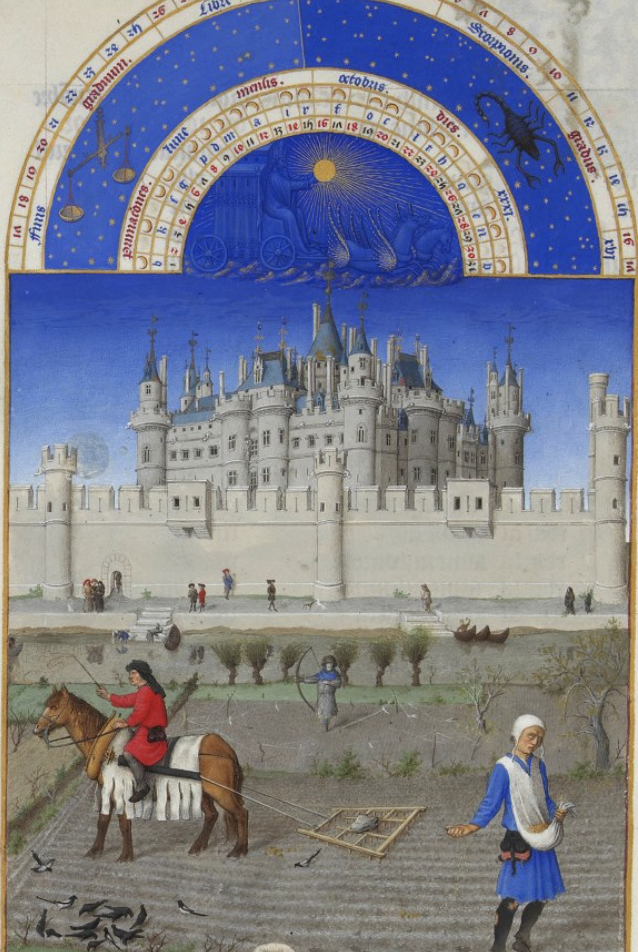
“October folio”
From Les Tres Riches Heures du Duc de Berry
Intermediate illuminator (incomplete and finished by another artist, perhaps Barthelemy d’Eyck)
Sowing the winter grain
one man on a horse harrowing the land while the other sows the seeds
Central ground - sown filed with scarecrow dressed as an archer; criss cross strings
Details
cast shadows
Footprints
Reflection cast by the boats on the water
Earliest known representation of this type of reflection
Shows people’s daily lives
Louvre
large central tower: dungeon/royal treasure house
Square courtyard
View from the area of Duc de Berry’s Paris residence
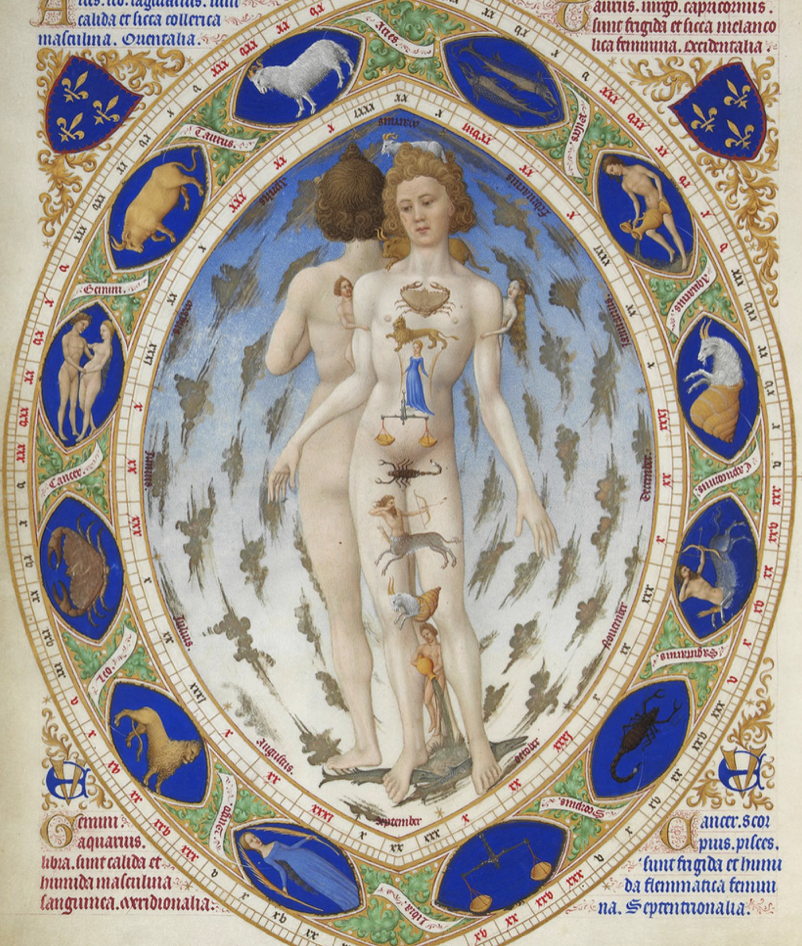
“Anatomical Man”
From the Les Tres Riches Heures du Duc de Berry
1410-16 and 1485-89
Limbourg Brothers
Unique theme and image in a book of hours
End of the calendar
Mirror images of a youth
Mandorla
almond shaped
Signs of the zodiac
Influence of the zodiac/stars (medical or astronomy)
Coat of arms of the Duc de Berry
Latin inscriptions
properties of each sign
Four humors/temperaments
Degree of hot or dry
Cardinal points
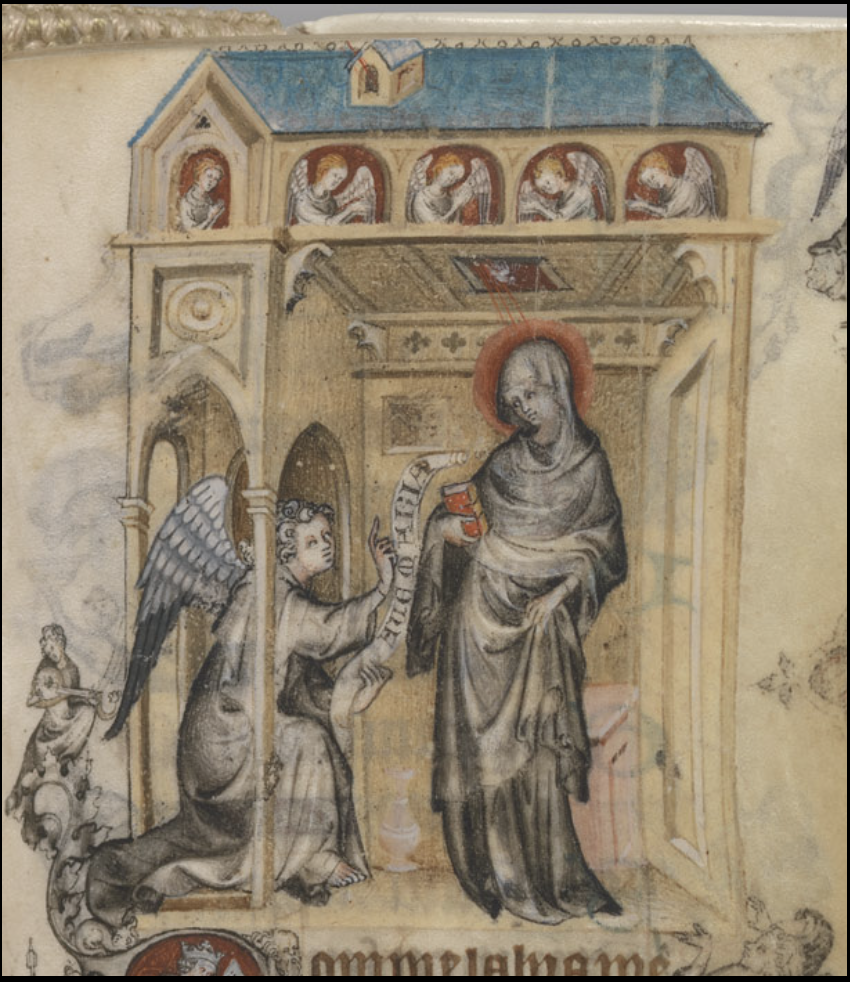
“Annunciation”
From the Hours of Jeanne d’Evreux
Jean Rucelle
First interior in a convincing 3D manner north of the Alps (3D but not to scale)
International gothic figural style
Courtly: refined
Italian influence
Annunciation iconography
Specific place: enclosed architecture
Typically separated by column or on different panels
Historiated Initial
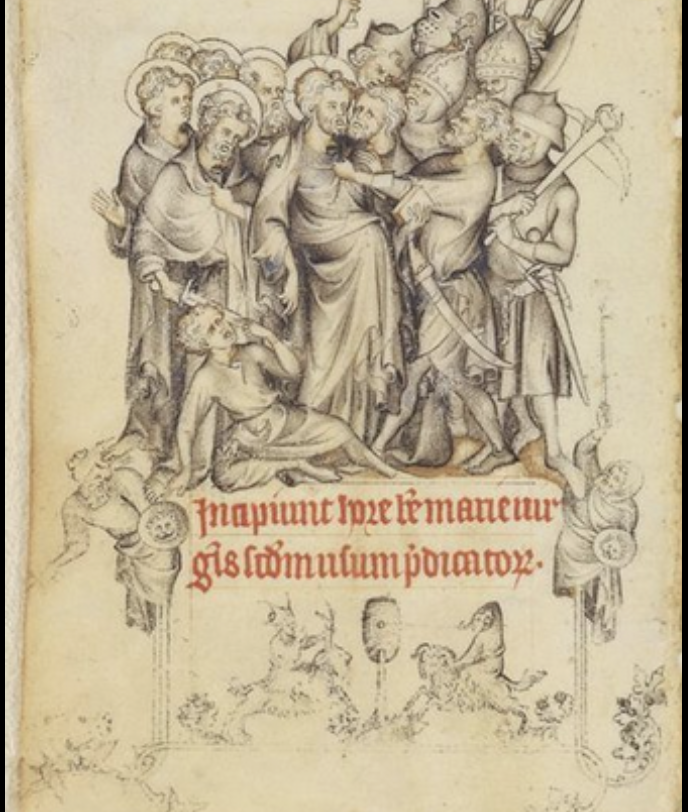
“Betrayal: Kiss of Judas”
From Hours of Jeanne d’Evreux
Jean Pucelle
C. 1326 CE
peter cutting off the ear of a solider
Medieval weapons
Crossbow anticipates the crucifixion
Mock tournament
bas-de-page
Theme associated with conflict
Knights on a goat and a ram (sin)
Charge at a keg on a post
“Titling at the water-butt”
Here a wine barrel
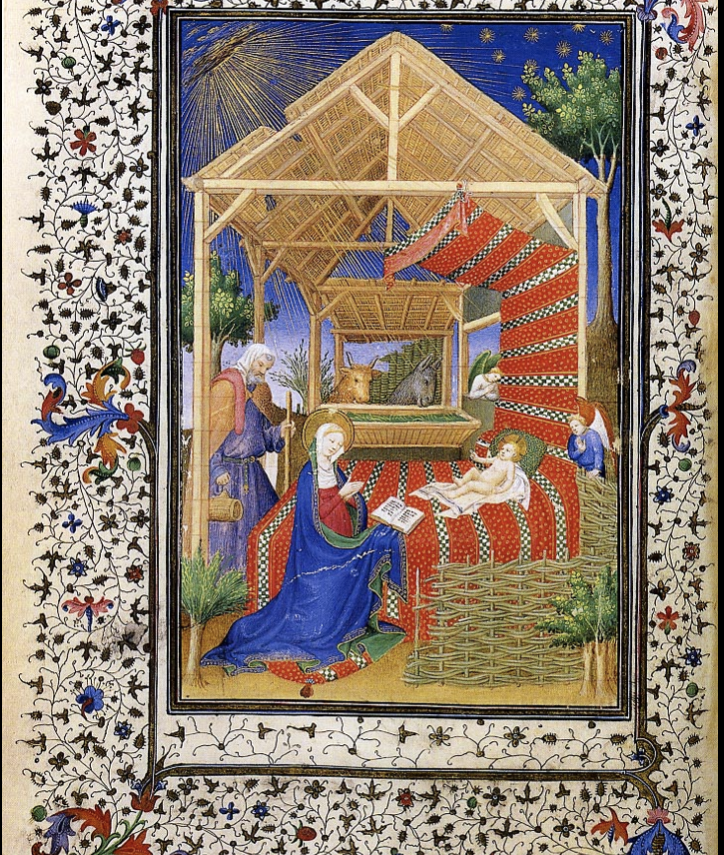
“Nativity”
Boucicaut Master from the Boucicaut Hours
C. 1408
Interest in landscapes
morning light
Ox and ass
Mary in blue cloak with a book
International gothic
tied to the tastes of European courts
Sinuous, carving forms
Undulation hems
Golden rays of sun
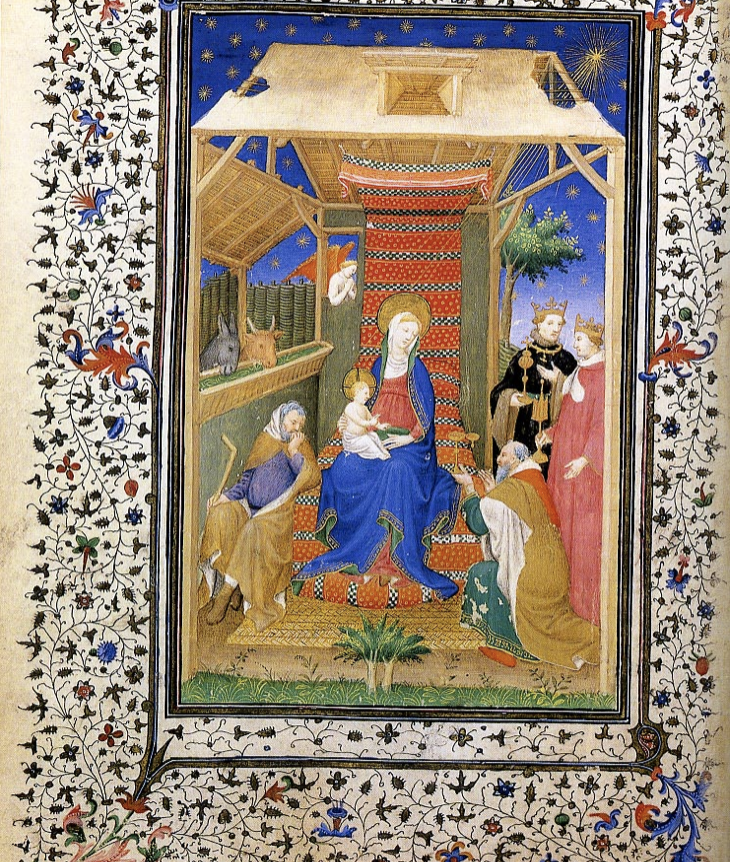
“Adoration of the Magi”
Boucicaut Master from the Boucicaut Hours
C. 1408
Star of Bethlehem
Placement of figures adds dimension
Retention of Medieval features
Gold haloes and stars
High point of view
Same location as Nativity turned 90 degrees
“Cloth of honor”
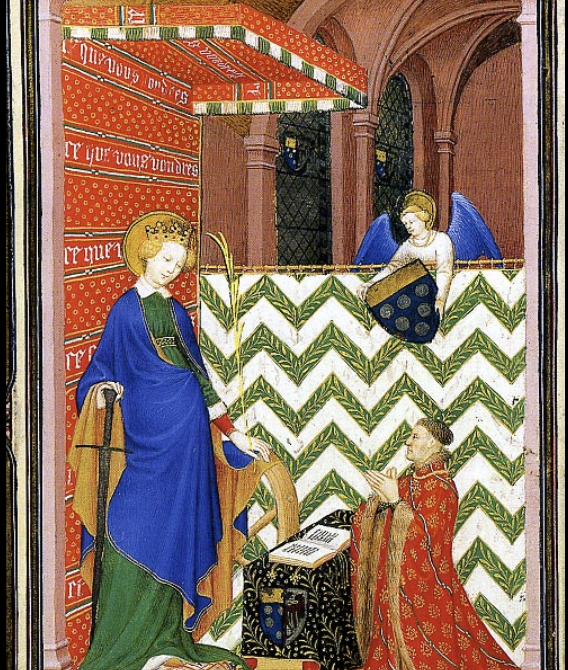
“Jean de Boucicaut before St. Catherine”
From the Boucicaut Master/ Boucicaut Book of Hours
C. 1408
Iconography of St. Catherine
wheel
Sword
Palm frond of Matyrdom
References to the Patron
coat of arms
“Impaled” coat of arms of prime-died and windows
Heraldic colors: green and white
Ce que vous voudres “whatever you wish”
Importance of scale
Implication of interior
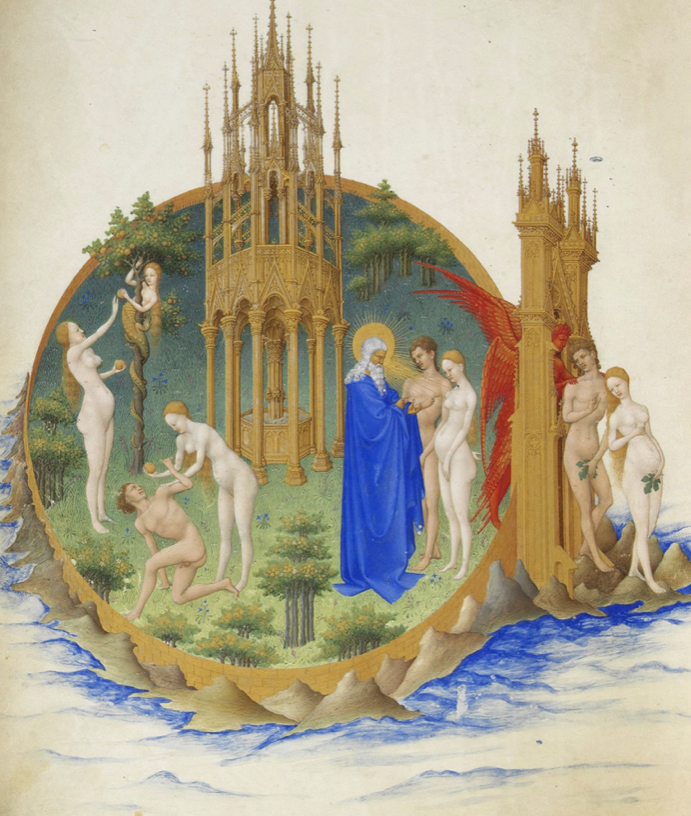
“Fall of Adam and Eve”
Tres Riches Heurs
Limbourg Brothers
Continuous narrative
Gothic fountain
Female imagery
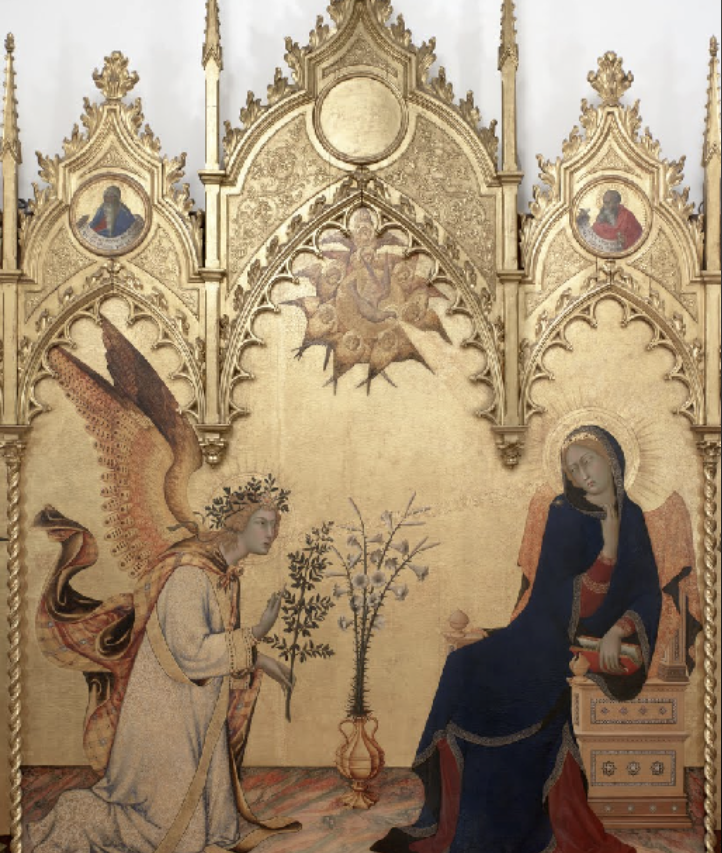
“Annunciation”
Simone Martini
1333
International gothic
late 14th to mid 15th centuries
Courtly painting, sculpture, and decorative art
Western Europe and Italy
Naturalistic details
Spatially illogical
Figures with oval heads and small mouths
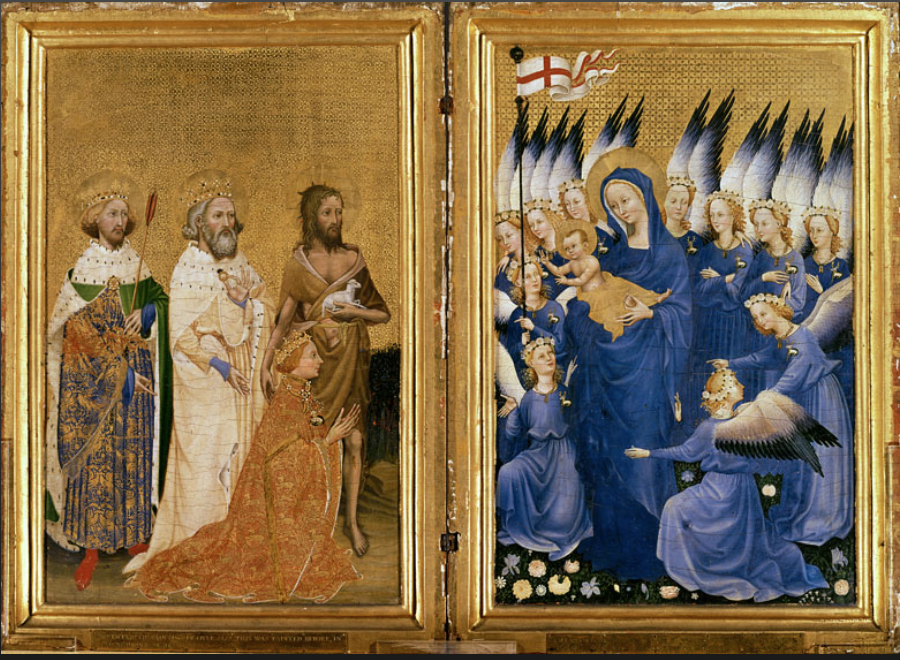
Front of the “Wilton Diptych”
Anonymous artist
1395
King Richard II of England presented by his patron saints (Edmund, Edward the Confessor, and John the Baptist) to the Virgin and Child with Angels
Named comes from the owner’s estate
Wilton House in Wiltshire, England
King Richard II kneeling
young man (He was an adult at the time of creation; image of him at 10 when he became king)
Three saints
two were English kings
Golds crowns with pearls
Gesture toward King Richard
support and present
Richard as a Holy King like his predecessors
Tooled background
St. Edmond: arrow (object os his murder)
St. Edward: ring (miracle)
St. John the Baptist: Lamb
White stag on the chain of pearls and Broom-cod
Design of the gold fabric
Right panel : Garden of Heaven
eleven angels
Pins of the white hart (stag)
Broom-cod collars
Roses instead of haloes
Interaction between figures
allusions to the crucifixion
lamb
Crown of thorns
Position of Christ
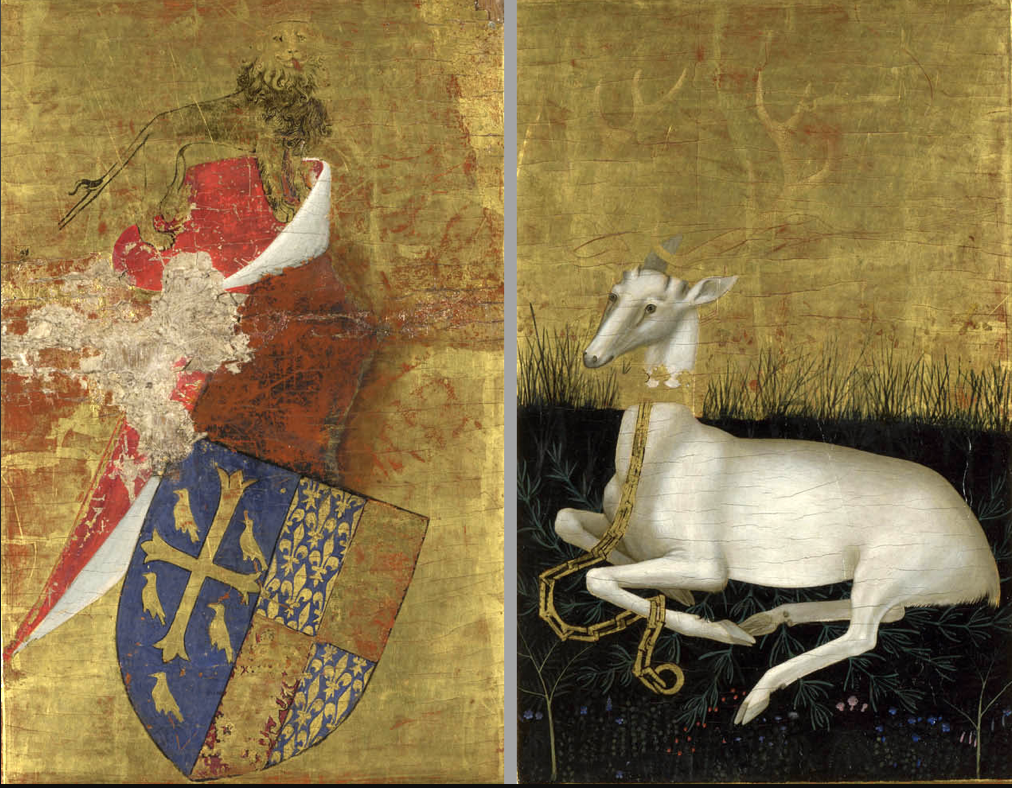
Back/Exterior of “Wilton Diptych”
Anonymous artist
C. 1395
Coat of arms of Richard II
lion with white hart
Elaborate chain
Crown
Antlers
Field of Rosemary
Condition is not as good as is the interior
Shield
“impaled”
Gold fleur de lys
Shadows of the three lions
Cross with five birds (Coat of arms of King Edward the Confessor)

Melchior Broederlam - Dijon Altarpiece Exterior
1394-99
Painted panels to protect precious relief sculpture
wings closed
Infancy/Life of Christ cycle
annunciation/visitation
Presentation/flight into Egypt
Alternating interior/ exterior space
Gold background
Byzantine convention
Paradise, otherworldly
Odd shape
contrived obligation to fill space
Annunciation
Iconography of the annunciation
Perspective: rudimentary
Shadow/light
Horus conclusus: enclosed garden
Gothic vs. Romanesque architecture
New Testament vs Old Testament
Annunciation and Visitation
Sacred architecture
Buildings in realistic manner
First time seen in Flemish painting
Gothic forms
Rectangular pavement
Colorful
Visitation
essence of the text from St. Luke
Mary and Elizabeth (gold halos; pregnant with John the Baptist and Christ)
Craggy mountains
Outdoors
Light and shadow
Early perspective
Creates depth
Presentation in the Temple and Flight into Egypt
apocryphal accounts
Stream/well in the desert
Statue falling from a high pedestal
Candlemas: February 2 (Date of the Presentation)
Flight into Egypt
Event from the Book of Matthew
Holy family crossing the desert (contemporary cistern replaces stream)
Statue broken from its base (destruction of pagan images)
Netherlandish interest in depicting detail
Very early if not the first
Joseph as an ordinary man
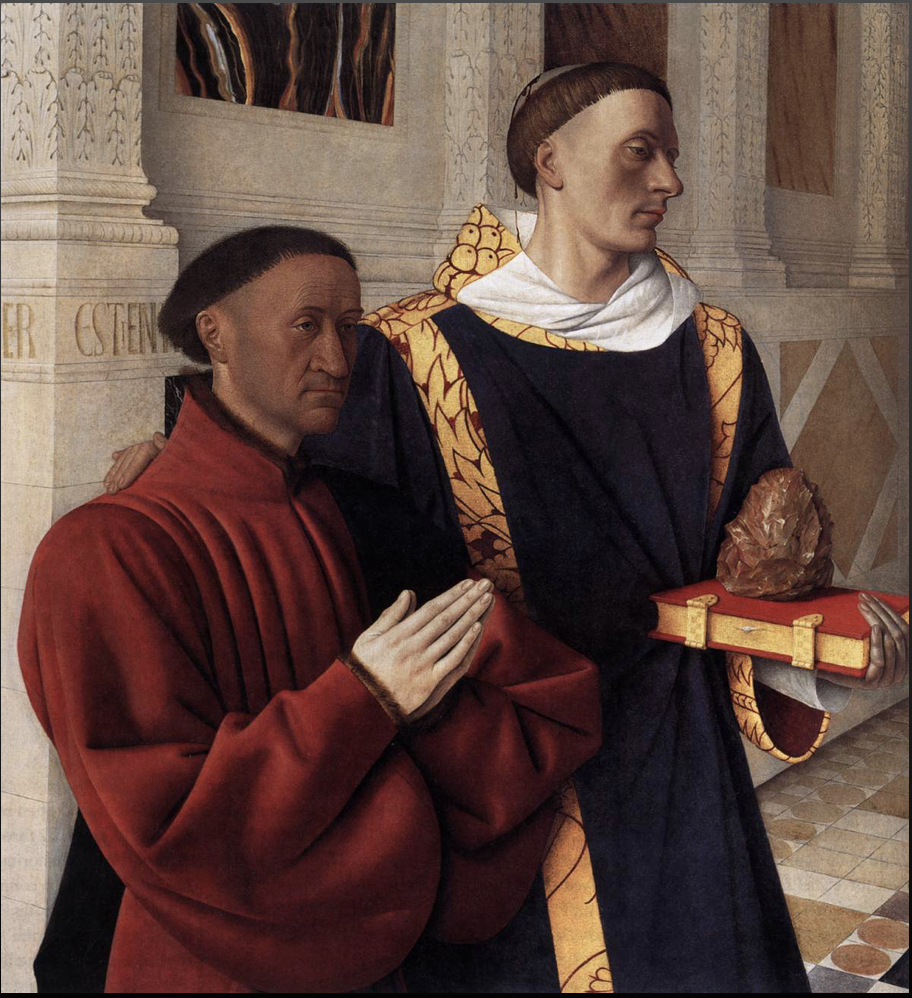
Left Panel of “Diptych of Melun”
Jean Fouquet
Estienne Chevalier with St. Stephen
portrait vs idealized
Patron Saint of Estienne Chevalier
first Christian martyr
Jerusalem
36 CE
First patron on return to France from Rome
C. 1450
Treasurer of France
Reign of King Charles VII (1422-61)
“IER ESTIEN”
engraving behind chevalier’s head
Marble panels
Perspective
Italian influence
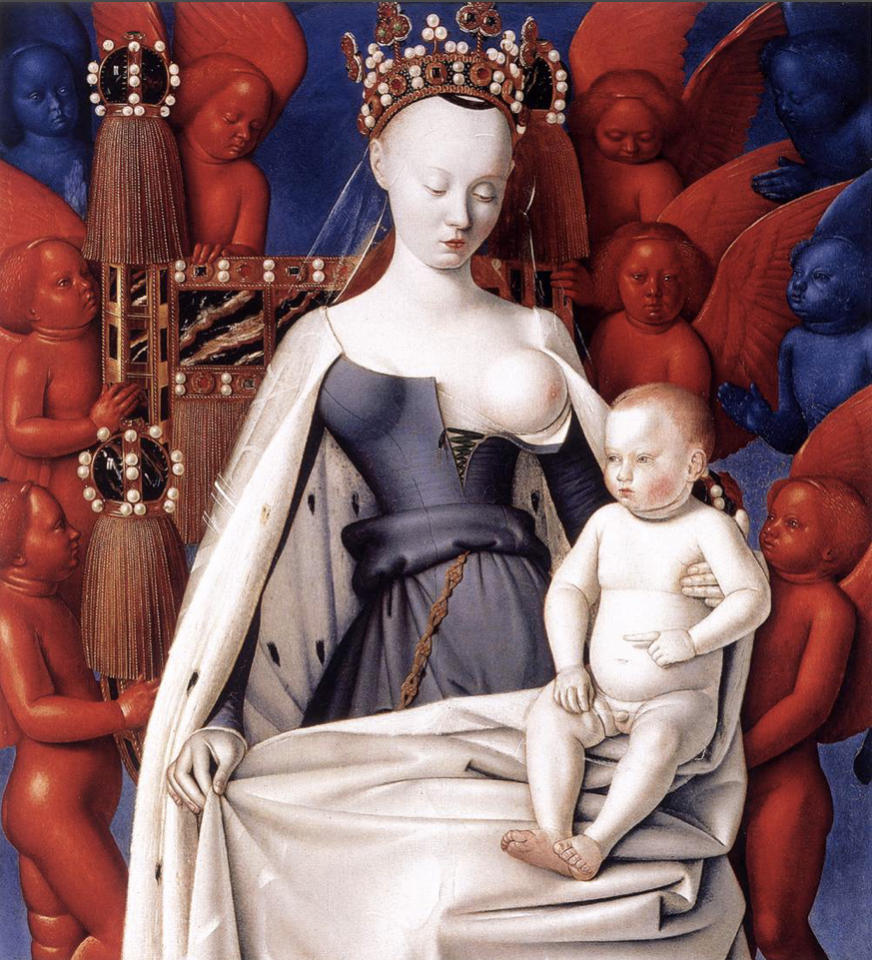
Left Panel of “Diptych of Melun”
Jean Fouquet
C. 1450
Madonna and Child (enthroned)
Surrounded by Seraphim and Cherubim (hierarchy of angels)
red, white, and blue
Heraldic colors of the king
Identification
Agnes Sorel : Mistress of King Charles V
Cathrine Bude : Wife of Cevalier
Diptych of Melun
worldly vs heavenly
Child points to the patron, Etienne Chevailier
Interactions between the panels
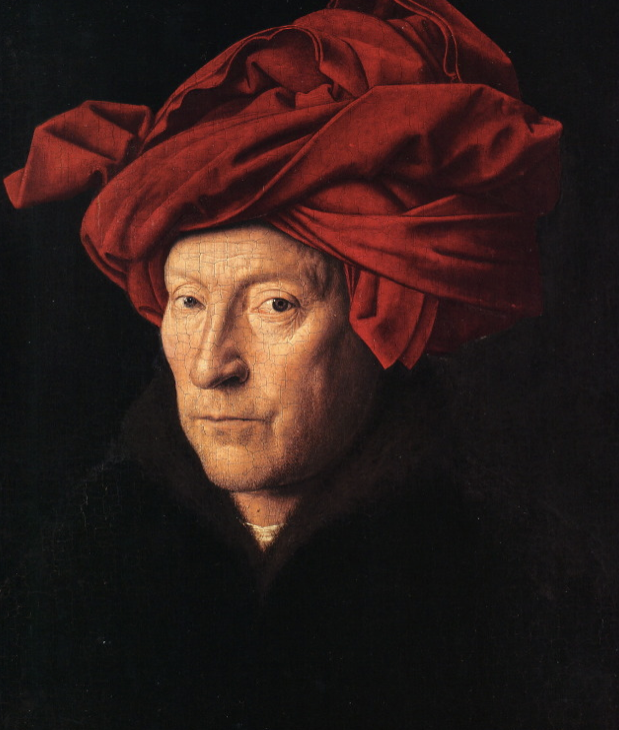
“Portrait of a Man” (possible self portrait)
Jan van Eyck
first early Netherlandish artist to sign his paintings
In 1425, appointed painter and barley du chamber to Phillip, Duke of Burgundy
C. 1433
Signed and inscribed on the frame
“ALS ICH CAN” : “I do as I can”
“Jan van Eyck made me on 21 October 1433”
Only early Netherlandish artist to adopt a personal motto

“Turin-Milan Hours”
C. 1420-35
“Hand G” possible attribution to Jan van Eyck
Only two miniatures survived
Innovative approach to illusionism and play of light
Depicts the Birth of St. John the Baptist, The Funeral Mass, and the Baptism of Jesus
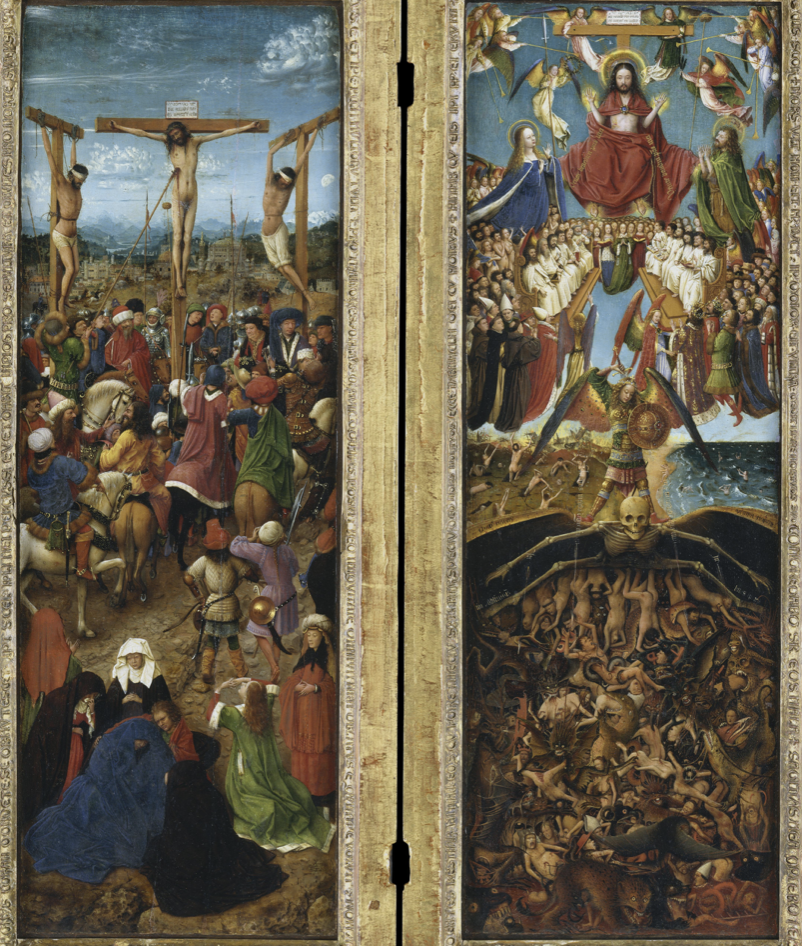
“Crucifixion and Last Judgement”
Jan van Eyck
C. 1430
Diptych or wings of a triptych
Death and Resurrection
sorrow and triumph
Mortal and immortal
Highly detailed iconography
“Microcosmic”
Original gilt (gold leaf)
Latin text around the inner edge of the original frames
Low relief decoration in gesso or clay
Traditional iconography of the crucifixion
Sybil (pre-Christian) who predicted Christ’s birth
Patron: looking out to the viewer. Blue Chaperon and Ermine lined clothing
Last Judgment
top and bottom vs left and right
Jesus sitting in judgement
Archangel Michael (warrior angel, rainbow wings)
Personifications of death (winged grinning skeleton)
Earliest evidences of the use of optical projections is in the paintings of Jan van Eyck
Concurrent with the invention of spectacles in Italy in 1276
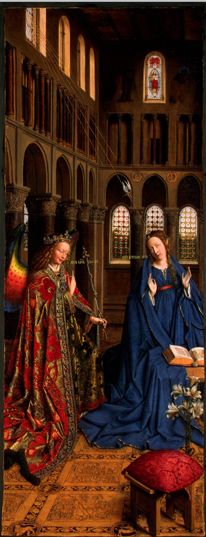
“Annunciation”
Jan va Eyck
1400s
vertical format (tradition from French manuscript illumination)
perspective is from the left side
evidence of a possible triptych?
classic Annunciation iconography
including the prie-dieu that Mary sits on
except Gabriel wears a crown not a halo and he is wearing a red and gold jeweled cope with a scepter
Color symbolism
speaking from the manuscript (verses from Luke)
forms have weight and volume
naturalism
Eyck was interested in distinguishing between textures
Gabriel and Mary are speaking; Mary’s words are upside downs because she is speaking to God.
Details
early gothic church interior (not representing a particular church)
difference in arches (romanesque vs gothic)
symbolism of light (darker in upper stories)
Gabriel wears “a gothic smile”
bottle glass windows (Netherland style)
repetition of seven (arches, lilies, gold beams of light)
historiated pavement (scenes of Old Testament)
Signs of the zodiac
Gabriel stands over Aries (the Annunciation happened on March 25, during Aries season)
Mary stands of Virgo (for the virgin)
Relationship between the Old Testament and New Testament
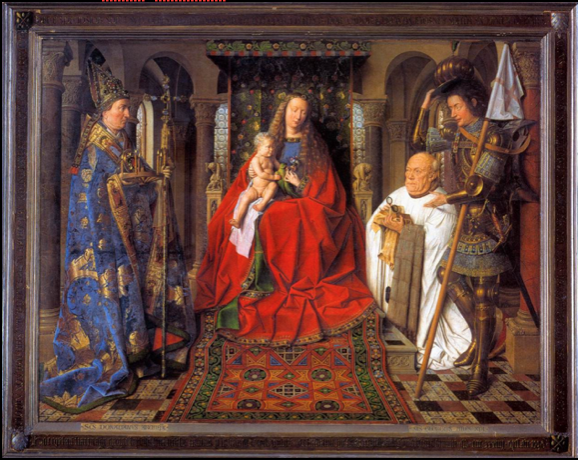
“The Madonna with Canon Van der Paele”
Jan van Eyck
set up like a triptych but is one painting
depicts the Madonna and child enthroned
in the center of the painting (most important part of a painting)
acts as almost an altar
romanesque religious building
reality of the fabrics and gems
asymmetrical
Mary and Christ look to the left
Nosegay and parakeet are allusions to the Garden of Eden
paradise
Mary and Christ are referred to as the second Adam and Eve (those who save the world from sin)
The patron (Canon Van der Paele) looks through Mary meaning he is only seeing the saints spiritually
Gleaming metal
St. George stands next to the patron
theme of defeat over death
Old Testament stories represented as wood cravings on the throne
Abraham sacrificing Isaac
Adam and Eve
Cain killing Abel
Samson and the Lion